As the world battles yet another variant of COVID-19, the scientific community is working tirelessly to understand the characteristics of the new strain. Recently, Dr.
Kostas Mosialos, a professor at the University of Athens, Greece, shed light on a specific mutation found in the OMICRON variant – the “BA2” mutation. This article explores the significance of BA2 in Mosialos’ take on OMICRON.
What is OMICRON?
OMICRON is the latest variant of the SARS-CoV-2 virus, which causes COVID-19. It was first detected in South Africa in late November 2021 and has since been reported in over 100 countries worldwide.
According to the World Health Organization (WHO), OMICRON has a higher number of mutations than any other variant of COVID-19.
What is the “BA2” Mutation?
The “BA2” mutation is one of the many mutations found in the spike protein of the OMICRON variant. The spike protein is the key to the virus’s ability to infect healthy cells and cause illness.
Mutations in the spike protein make it difficult for antibodies to recognize and neutralize the virus.
The BA2 mutation is unique as it is located near the furin cleavage site of the spike protein. The furin cleavage site is a region that enables the spike protein to be easily cleaved and activated, leading to easier penetration into human cells.
Mosialos’ Take on BA2
Dr. Kostas Mosialos is a professor of Pharmacology and Biotechnology at the University of Athens, Greece. Since the emergence of the OMICRON variant, he has been closely monitoring its genetic makeup.
According to Mosialos, the presence of the BA2 mutation in the OMICRON variant may have significant consequences for the effectiveness of vaccines and therapeutics.
Mosialos explains that the location of the BA2 mutation near the furin cleavage site suggests a possible increase in the virus’s pathogenicity. Pathogenicity is the ability of a microorganism to cause illness in an organism.
Thus, the presence of BA2 could increase the severity of COVID-19 in infected individuals.
Furthermore, Mosialos states that the BA2 mutation could make it difficult for certain monoclonal antibodies to recognize and neutralize the virus.
Monoclonal antibodies are laboratory-made proteins that mimic the immune system’s ability to fight off viruses. They are an important component of COVID-19 treatments and therapies.
What Does the BA2 Mutation Mean for Vaccines and Therapeutics?
The BA2 mutation’s location near the furin cleavage site could enable the OMICRON variant to more easily penetrate human cells, thus increasing its transmissibility and pathogenicity.
According to Mosialos, this may lead to a decrease in the effectiveness of some vaccines and therapeutics.
However, it is important to note that the BA2 mutation is only one of many mutations found in the OMICRON variant. Other mutations, such as the E484A mutation, have also been reported to affect the virus’s response to vaccines and therapies.
Despite the potential impact of the BA2 mutation on vaccines and therapeutics, the effectiveness of these treatments against OMICRON is still under investigation.
Mosialos suggests that the key to combating the spread of OMICRON is to continue vaccination efforts and follow public health guidelines to slow transmission rates.
Conclusion
The BA2 mutation in the OMICRON variant is a cause for concern, given its location near the furin cleavage site. Dr.
Kostas Mosialos suggests that the presence of BA2 could increase the virus’s pathogenicity and decrease the effectiveness of some vaccines and therapeutics. While more research is needed to fully understand the impact of BA2 on OMICRON, it is clear that continued vaccination efforts and adherence to public health guidelines remain crucial in limiting the spread of COVID-19.























